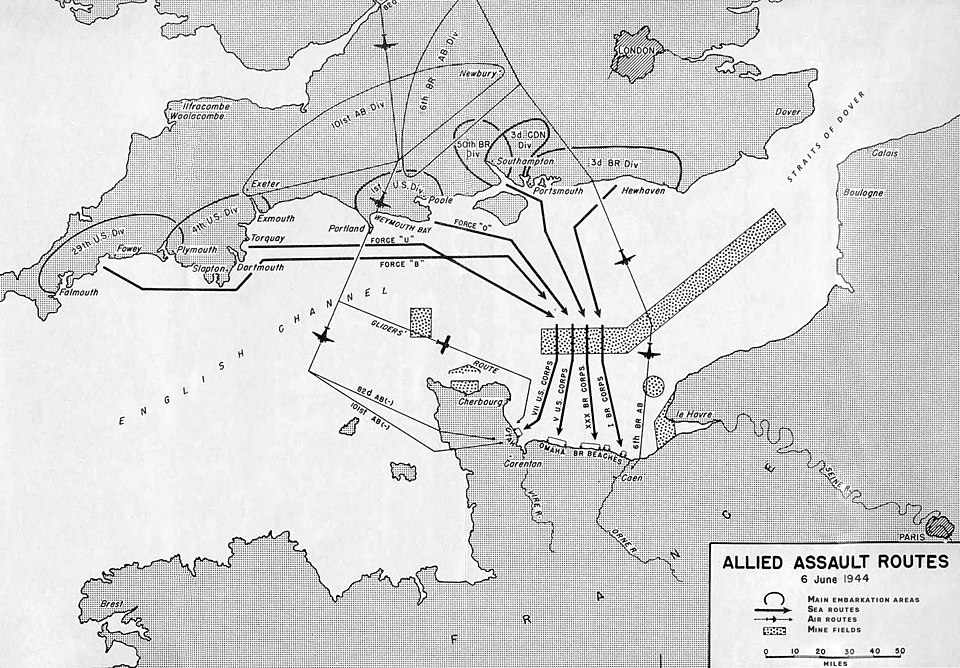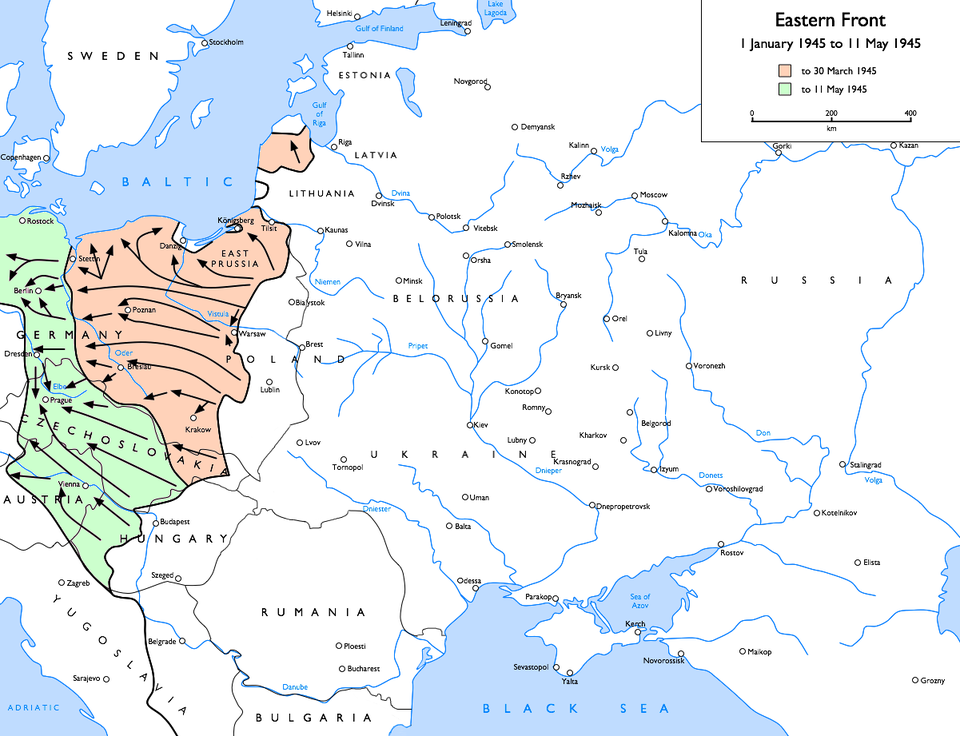OCR Specification focus:
‘the ‘liberation of Europe in the East and West’’
The liberation of Europe during and immediately after the Second World War shaped the ideological confrontation between East and West, laying the foundations of the Cold War.
The Concept of Liberation
The term liberation referred to the military and political freeing of territories occupied by Nazi Germany between 1944 and 1945. While both the Western Allies and the Soviet Union claimed to be liberating Europe, their approaches, motives, and the political systems they encouraged led to starkly different outcomes.
Liberation: The process of freeing countries and territories from Nazi occupation during the Second World War, often followed by the imposition or encouragement of political systems by the liberators.
Western Europe was generally restored to democratic systems, while Eastern Europe came under increasing Soviet control, highlighting the division between capitalism and communism.
Liberation in the West
The Western Allies – principally the United States, Britain, and later France – carried out a series of campaigns in Western Europe from 1944.
Key Developments
D-Day (Operation Overlord), June 1944: Allied forces landed in Normandy, leading to the liberation of France and the Low Countries.
Paris Liberation (August 1944): Celebrated as a moment of national pride, though heavily dependent on Allied military success.
Italy: Although liberated earlier in 1943–44, it remained a contested zone with significant Allied influence over its political restructuring.
Restoration of Democracy: Western nations encouraged the re-establishment of parliamentary systems and free elections.
In the West, the Allied ‘liberation’ narrative centred on Operation Overlord (D-Day, 6 June 1944) and subsequent advances through France, Belgium and the Netherlands into western Germany.

Allied assault routes onto Utah, Omaha, Gold, Juno and Sword beaches on 6 June 1944. Arrows indicate naval approach lanes and landing sectors that opened the Western front in France. The diagram supports analysis of how the Western lodgement enabled the liberation of North-West Europe. Source
Political Outcomes
Western Europe generally accepted Marshall Aid and other Western initiatives after 1945.
Liberation was associated with renewed sovereignty, despite initial Allied military occupation.
Crucially, there was no permanent imposition of Western military or political structures beyond NATO, formed later in 1949.
Liberation in the East
The Soviet Red Army advanced across Eastern Europe from 1944, pushing German forces back through a series of major offensives.
Key Developments
Poland: Warsaw was entered in January 1945, but Soviet support for uprisings such as the Warsaw Rising (August 1944) was minimal, heightening mistrust.
Baltic States: Reoccupied by the USSR and fully incorporated into Soviet territory by 1945.
Bulgaria, Romania, and Hungary: Liberated from German occupation but quickly brought under Soviet influence through political control and military presence.
Czechoslovakia: Liberated by both Soviet and Western troops, though the capital Prague was taken by the Red Army, increasing Soviet leverage.
Between 1944 and 1945 the Red Army advanced westward through Poland, Romania, Bulgaria, Hungary and into eastern Germany, liberating territory but consolidating military-political control.

Map of Soviet operations from January to May 1945, with arrows and date ranges marking major offensives and the approach to Berlin. It shows liberation in the East as a sequence of strategic drives rather than isolated battles. Source
Political Outcomes
The Soviet model emphasised ‘friendly’ communist governments, often installed under pressure.
Countries were bound into the Soviet sphere by political purges, economic dependency, and military occupation.
By 1948, people’s democracies in Poland, Hungary, Romania, and Bulgaria effectively mirrored Moscow’s authority.
Contrasting Approaches to Liberation
The West and East both presented themselves as liberators, but their interpretations of freedom diverged sharply.
Western Vision
Emphasis on self-determination (a principle stressed by Roosevelt).
Restoration of democratic governance and economic reconstruction through capitalism.
Limited occupation and eventual withdrawal, allowing countries autonomy.
Soviet Vision
Emphasis on security: Stalin believed that controlling Eastern Europe created a buffer zone against future invasions.
Promotion of communism, often through the suppression of rival political groups.
Permanent military and political presence, effectively transforming liberation into domination.
Buffer Zone: A group of states between two major powers, serving as a protective barrier. In the Cold War, Eastern Europe functioned as the USSR’s buffer zone against the West.
Liberation and Early Cold War Tensions
The different methods of liberation directly influenced the emerging East–West divide.
Seeds of Tension
The West viewed Soviet control as a betrayal of agreements on free elections made at the Yalta Conference (1945).
The Soviets accused the West of delaying the opening of a Second Front until 1944, interpreting it as an attempt to weaken the USSR.
In liberated territories, conflicting political systems created spheres of influence that overlapped, particularly in Germany and Austria.
Viewed together, liberation progressed along two converging axes—Anglo-American forces from the West and the Soviet armies from the East—meeting on the Elbe in April 1945.
Long-Term Consequences
Western Europe entered into US-led alliances and economic structures, culminating in NATO.
Eastern Europe remained locked under Soviet dominance until the late 1980s.
The liberation of Europe thus not only ended Nazi occupation but also shaped the ideological and territorial boundaries of the Cold War.
Significance of Liberation Narratives
Both sides mythologised their roles in liberation:
In the West, liberation symbolised victory for democracy, freedom, and capitalism.
In the East, it was framed as the triumph of socialism and the protection of Europe from fascism.
This duality established incompatible narratives that fed Cold War propaganda and justified policies of expansion and containment on both sides.
FAQ
The Western Allies associated liberation with rebuilding societies based on freedom and parliamentary democracy. This reflected their ideological commitment to capitalism and liberal democracy.
They also believed that restoring democratic governments would stabilise Europe, reduce the risk of future authoritarian regimes, and encourage cooperation with the United States and Britain.
Reactions were mixed. Many initially welcomed the Red Army as liberators from Nazi occupation.
However, enthusiasm quickly faded when Soviet forces imposed communist regimes, requisitioned resources, and repressed non-communist political movements. Resistance movements, such as the Polish Home Army, often clashed with Soviet interests.
Both East and West used propaganda to frame their role as liberators.
In the West: Liberation was portrayed as the triumph of democracy and freedom over tyranny.
In the East: Soviet propaganda stressed the Red Army’s sacrifice and depicted communism as the only safeguard against fascism.
These narratives entrenched ideological divides even before the Cold War formally began.
The Warsaw Uprising (August 1944) highlighted Soviet priorities.
While Polish resistance rose against German occupation, the Red Army halted nearby, allowing the uprising to be crushed. Stalin’s decision not to aid the Poles revealed his intention to weaken non-communist groups and ensure Soviet dominance in Poland after the war.
Liberation determined the political geography of post-war Europe.
Territories liberated by the West (France, Belgium, Netherlands) fell into the Western democratic sphere.
Areas liberated by the Soviets (Poland, Romania, Bulgaria, Hungary, eastern Germany) became part of the communist bloc.
The “line of liberation” later mirrored the Iron Curtain, marking the divide between East and West until 1989.
Practice Questions
Question 1 (2 marks):
Name one country liberated by the Western Allies in 1944–45 and one country liberated by the Soviet Union in the same period.
Mark Scheme:
1 mark for correctly identifying one country liberated by the Western Allies, e.g. France, Belgium, the Netherlands, Italy (post-1943).
1 mark for correctly identifying one country liberated by the Soviet Union, e.g. Poland, Hungary, Romania, Bulgaria, Czechoslovakia, the Baltic States, eastern Germany.
(Maximum 2 marks)
Question 2 (6 marks):
Explain two differences between the approaches of the Western Allies and the Soviet Union to the liberation of Europe, 1944–45.
Mark Scheme:
Up to 3 marks for each explained difference.
To gain full marks, answers must include both identification of the difference (1 mark) and clear explanation of why/how it was different (2 marks).
Examples of valid points:
Political outcomes: Western Allies generally restored democratic systems (identification, 1 mark). This contrasted with the Soviets, who imposed communist-controlled governments (explanation, 2 marks).
Military presence: Western occupation forces were temporary with plans for withdrawal (identification, 1 mark). In contrast, Soviet forces remained in place, using military control to dominate politics (explanation, 2 marks).
Self-determination vs security: Western Allies emphasised national self-determination (identification, 1 mark), whereas Stalin prioritised creating a buffer zone for Soviet security (explanation, 2 marks).
(Maximum 6 marks)

